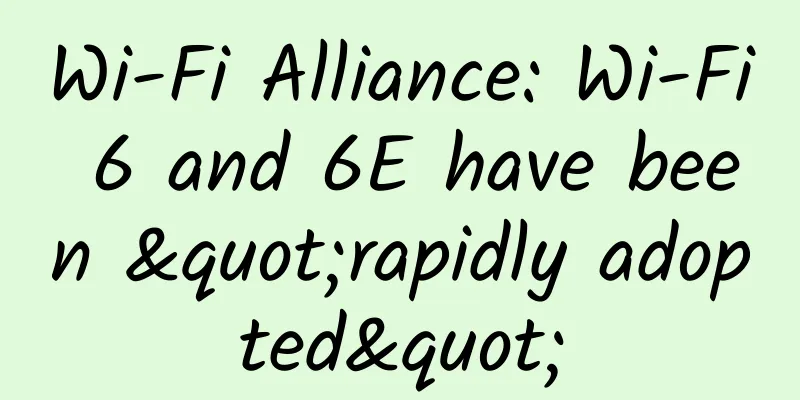Wi-Fi Alliance: Wi-Fi 6 and 6E have been "rapidly adopted"

|
By 2025, Wi-Fi 6 and Wi-Fi 6E are expected to exceed 80% market share. The Wi-Fi Alliance certified the sixth generation of Wi-Fi in 2019, followed by Wi-Fi 6E in 2021. Since then, Wi-Fi 6 has seen "rapid adoption," the alliance said, with Wi-Fi 6 exceeding 50% market share. Three areas are driving the Wi-Fi 6 and 6E market: products, deployment, and regulation. productAccording to data from the Wi-Fi Alliance, more than 2.3 billion Wi-Fi 6 products and 350 million Wi-Fi 6E products are expected to enter the market in 2022, and Wi-Fi 6E will account for more than 15% of all Wi-Fi 6 shipments this year. In a press statement, Edgar Figueroa, president and CEO of the Wi-Fi Alliance, said that more than 400 Wi-Fi 6E devices have been certified, a category that includes more than 70 laptop models, dozens of consumer and enterprise access points, smartphones, and smart TVs. By 2025, Wi-Fi 6 and Wi-Fi 6E are expected to exceed 80% market share, dominating the smartphone market. In addition, Broadcom has shipped more than 1 billion Wi-Fi 6 and Wi-Fi 6 E chips, and Extreme Networks said in an earnings call that Wi-Fi 6E accounts for 10% of its bookings. deployThe benefits of Wi-Fi 6E, which brings the capabilities of Wi-Fi 6 to the 6 GHz band, have been demonstrated in multiple verticals, including healthcare and education. For example, the University of Michigan installed more than 15,000 Aruba AP-635 indoor model Wi-Fi 6E access points across its campus. The project took eight months and cost $11 million and was completed in April this year. “People are downloading at speeds of 300 to 400 megabits per second, which has enabled us to reduce the number of wired ports on campus and reduce the number of switches in all of our cabinets,” commented Ravi Pendse, the university’s vice president of IT and chief information officer. “That’s nearly 80,000 wired ports to remove or reduce. That saves us thousands of switches.” RegulationThe United States was the first country to open the 6 GHz band for Wi-Fi; however, more than 60 countries in the Americas, EMEA, and Asia Pacific have already or are considering doing so. Countries such as Brazil, Canada, Chile, Costa Rica, Guatemala, Honduras, Peru, Saudi Arabia, South Korea, and the United Arab Emirates have already used the upper and lower 6 GHz bands (5925-7125 MHz) for Wi-Fi 6E, while other countries such as Saudi Arabia want to use the entire 1200 MHz spectrum in the 6 GHz band for Wi-Fi, a position that the alliance "appreciates." |
>>: A thorough understanding of container network communication
Recommend
Huawei: 5G+AI opens a new era of smart city twins
On November 15, the "Huawei Smart City Summi...
WOT Cheng Chao: Alibaba's monitoring development path from automation to intelligence
[51CTO.com original article] On May 18-19, 2018, ...
What does 5G bring to the Internet of Things today and tomorrow?
The Internet of Things is already booming, and we...
Good news! 5G is so important, China Mobile has made a great contribution
When it comes to 5G networks, everyone should be ...
Foreign operators are using 5G to replace wired broadband. Will domestic operators do the same?
In the imagination of domestic users, the main ap...
The Legend of Network Protocols (IV): Be Careful in the Evolutionary Path
Vinton Cerf, who is revered as the "Father o...
5G is coming, but how fast?
Wireless networking is truly part of the culture ...
What is the value of 5G at the edge?
A lot of people have been questioning the value o...
ProfitServer New Year Russian VPS Hosting 20% off, Moscow/Chelyabinsk Data Center Available
ProfitServer is a Russian hosting company founded...
Eight data center technologies verified in 2015
2015 was a year in which new technologies matured...
edgeNAT September Promotion: 20% off for monthly VPS and 30% off for annual VPS starting from 48 yuan/month, in the US/Hong Kong/Korea data centers
edgeNAT has launched a promotional event for the ...
Do you know all the things you need to pay attention to when using threads?
[[344283]] This article is reprinted from the WeC...
ITU releases draft specification, a big step forward in 5G standardization
According to foreign media reports, despite the o...
There have been three waves of "network withdrawal" around the world. When will domestic operators complete the withdrawal of 2/3G networks?
Recently, Ericsson released the ten-year special ...
IPv6 has a "red" start, and Internet giants are showing their talents!
After "getting up early and arriving late&qu...









